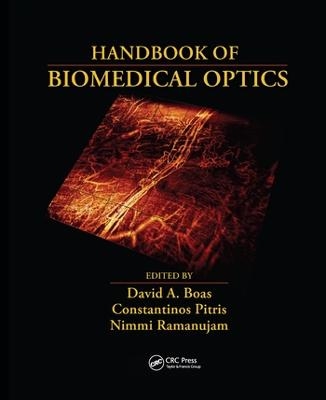
Handbook of Biomedical Optics
CRC Press (Verlag)
978-0-367-57694-3 (ISBN)
Biomedical optics holds tremendous promise to deliver effective, safe, non- or minimally invasive diagnostics and targeted, customizable therapeutics. Handbook of Biomedical Optics provides an in-depth treatment of the field, including coverage of applications for biomedical research, diagnosis, and therapy. It introduces the theory and fundamentals of each subject, ensuring accessibility to a wide multidisciplinary readership. It also offers a view of the state of the art and discusses advantages and disadvantages of various techniques.
Organized into six sections, this handbook:
Contains introductory material on optics and the optical properties of tissue
Describes the various forms of spectroscopy and its applications in medicine and biology, including methods that exploit intrinsic absorption and scattering contrast; dynamic contrast; and fluorescence and Raman contrast mechanisms
Provides extensive coverage of tomography from the microscopic (optical coherence tomography) to the macroscopic (diffuse optical tomography) to photoacoustic tomography
Discusses cutting-edge translations to biomedical applications in both basic sciences and clinical studies
Details molecular imaging and molecular probe development
Highlights the use of light in disease and injury treatment
The breadth and depth of multidisciplinary knowledge in biomedical optics has been expanding continuously and exponentially, thus underscoring the lack of a single source to serve as a reference and teaching tool for scientists in related fields. Handbook of Biomedical Optics addresses this need, offering the most complete up-to-date overview of the field for researchers and students alike.
Dr. David A. Boas is an Associate Professor at the Harvard Medical School and Associate Physicist at Massachusetts General Hospital in Boston, Massachusetts. He received his Bachelors Degree in Physics from Rensselaer Polytechnic Institute, Troy NY in 1991 and his Doctorate from the University of Pennsylvania, Philadelphia, PA, also in Physics. His research interests include the following: photon migration in highly scattering media with emphasis on diffuse optical tomography, clinical applications of diffuse optical tomography in brain and breast radiology and fundamental studies of brain function and stroke using diffuse optical tomography and optical microscopy. Dr. Boas has been an Associate Editor of Optics Express and Guest Editor of Medical Physics and Journal of Biomedical Optics. He is a member of SPIE and the Optical Society of America (OSA), and has served as Conference Program Chair for various OSA topical meetings. Dr. Constantinos Pitris is an Assistant Professor in the faculty of Electrical and Computer Engineering at the University of Cyprus. He completed his studies at the University of Texas at Austin (BS Honors in Electrical Engineering, 1993, MS in Electrical Engineering, 1995), Massachusetts Institute of Technology (Ph.D. in Electrical and Medical Engineering, 2000), and Harvard Medical School (MO Magna Cum Laude in Medicine, 2002). He has worked as a research assistant at the University of Texas and Massachusetts Institute of Technology and as a postdoctoral associate at the Wellman Laboratories of Photomedicine of the Massachusetts General Hospital and Harvard Medical School. His main research interests cover the areas of optics and biomedical imaging. The goal of this research is the introduction of new technologies in clinical applications for the improvement of diagnostic and therapeutic options. He is an active member of the OSA and a reviewer for Optics Letters, Applied Optics and Biomedical Optics. Dr. Nimmi Ramanujam is an Associate Professor of Biomedical Engineering at Duke University. Dr. Ramanujam earned her Ph.D. in Biomedical Engineering from the University of Texas, Austin in 1995 and trained as an NIH postdoctoral fellow at the University of Pennsylvania from 1996-2000. Prior to her tenure at Duke, she was an assistant professor in the Department of Biomedical Engineering at the University of Wisconsin, Madison from 2000-2005. Dr. Ramanujam's interests in the field of biophotonics are centered on research and technology development for applications to cancer. She is developing novel quantitative optical sensing and imaging tools for translational applications in cancer research. She has been leading a multidisciplinary effort to translate these technologies into pre-clinical models and cancer patients. Dr. Ramanujam is a fellow of the OSA and was invited to be a panel member for the Department of Defense (DOD) Breast Cancer Research Program (BCRP) Integration Panel. She has received several awards for her work in cancer research and technology development, including Era of Hope Scholar awards from the DOD and a Global Indus Technovator award from MIT.
Background. Spectroscopy and Spectral Imaging. Tomographic Imaging. Microscopic Imaging. Molecular Probe Development. Phototherapy.
| Erscheinungsdatum | 01.07.2020 |
|---|---|
| Verlagsort | London |
| Sprache | englisch |
| Maße | 219 x 276 mm |
| Gewicht | 453 g |
| Themenwelt | Medizin / Pharmazie ► Physiotherapie / Ergotherapie ► Orthopädie |
| Naturwissenschaften ► Biologie | |
| Naturwissenschaften ► Physik / Astronomie ► Optik | |
| Technik ► Elektrotechnik / Energietechnik | |
| Technik ► Medizintechnik | |
| Technik ► Umwelttechnik / Biotechnologie | |
| ISBN-10 | 0-367-57694-5 / 0367576945 |
| ISBN-13 | 978-0-367-57694-3 / 9780367576943 |
| Zustand | Neuware |
| Haben Sie eine Frage zum Produkt? |
aus dem Bereich


